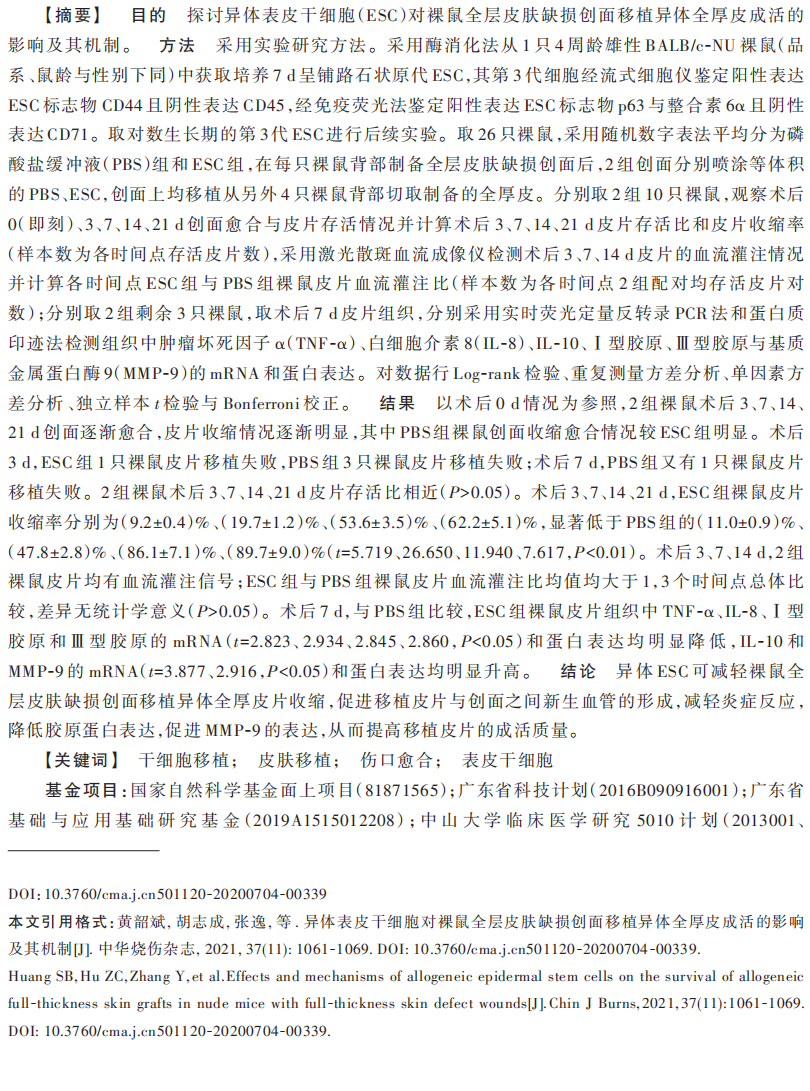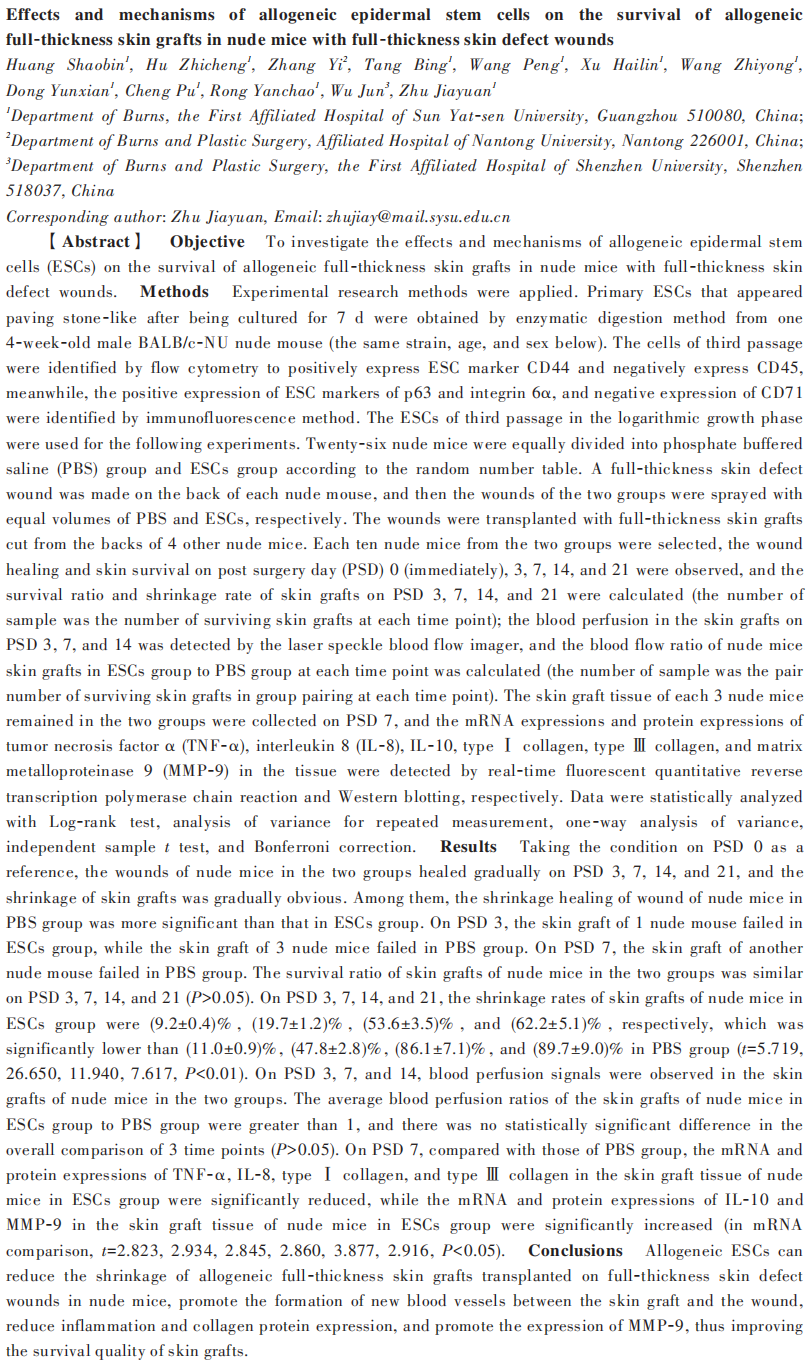文献精选
Marta Arnal‑Forné1 · Tamara Molina‑García2 · María Ortega2 · Víctor Marcos‑Garcés2,3 · Pilar Molina4 · Antonio Ferrández‑Izquierdo1,2,5 · Pilar Sepulveda1,6,7 · Vicente Bodí2,3,6,8 · César Ríos‑Navarro1,2,6 · Amparo Ruiz‑Saurí1,2,6
Accepted: 10 June 2024 / Published online: 2 July 2024
© The Author(s) 2024
Abstract
Skin represents the main barrier against the external environment, but also plays a role in human relations, as one of the prime determinants of beauty, resulting in a high consumer demand for skincare-related pharmaceutical products. Given the importance of skin aging in both medical and social spheres, the present research aims to characterize microscopic changes in human skin composition due to intrinsic aging (as opposed to aging infuenced by external factors) via histological analysis of a photoprotected body region. Samples from 25 autopsies were taken from the periumbilical area and classifed into four age groups: group 1 (0–12 years), group 2 (13–25 years), group 3 (26–54 years), and group 4 (≥55 years). Diferent traditional histological (hematoxylin–eosin, Masson’s trichrome, orcein, toluidine, Alcian blue, and Feulgen reaction) and immunohistochemical (CK20, CD1a, Ki67, and CD31) stains were performed. A total of 1879 images photographed with a Leica DM3000 optical microscope were morphometrically analyzed using Image ProPlus 7.0 for further statistical analysis with GraphPad 9.0. Our results showed a reduction in epidermis thickness, interdigitation and mitotic indexes, while melanocyte count was raised. Papillary but not reticular dermis showed increased thickness with aging. Specifcally, in the papillary layer mast cells and glycosaminoglycans were expanded, whereas the reticular dermis displayed a diminution in glycosaminoglycans and elastic fbers. Moreover, total cellularity and vascularization of both dermises were diminished with aging. This morphometric analysis of photoprotected areas reveals that intrinsic aging signifcantly infuences human skin composition. This study paves the way for further research into the molecular basis underpinning these alterations, and into potential antiaging strategies.
Keywords Skin aging · Intrinsic aging · Morphometric analysis · Human biopsies
César Ríos-Navarro
该Email地址已收到反垃圾邮件插件保护。要显示它您需要在浏览器中启用JavaScript。
* Amparo Ruiz-Saurí 该Email地址已收到反垃圾邮件插件保护。要显示它您需要在浏览器中启用JavaScript。; 该Email地址已收到反垃圾邮件插件保护。要显示它您需要在浏览器中启用JavaScript。
1 Department of Pathology, University of Valencia, Avda. Blasco Ibáñez 15. 46010, Valencia, Spain
2 Instituto de Investigación Sanitaria INCLIVA Biomedical Research Institute, Avda. Menéndez Pelayo 4acc,
46010 Valencia, Spain
3 Cardiology Department, Hospital Clínico Universitario, Valencia, Spain
4 Department of Pathology, Instituto de Medicina Legal y Ciencias Forenses, Valencia, Spain
5 Anatomic Pathology Department, Hospital Clínico Universitario, Valencia, Spain
6 Centro de Investigación Biomédica en Red (CIBER)-CV, Madrid, Spain
7 Regenerative Medicine and Heart Transplantation Unit, Instituto de Investigación Sanitaria La Fe, Valencia, Spain
8 Department of Medicine, University of Valencia, Valencia, Spain
Nguyen Ngan Giang1,2 Hyun Ji Kim3 Pham Ngoc Chien2,3 Han Jin Kwon4 Jung Ryul Ham4 Won Ku Lee4 Yeon Ju Gu4 Shou Yi Zhou2,5 Xin Rui Zhang2,5 Sun Young Nam2 Chan Yeong Heo1,2,3,5
1 Department of Medical Device Development, College of Medicine, Seoul National University, Seoul, Republic of Korea
2 Department of Plastic and Reconstructive Surgery, Seoul National University Bundang Hospital, Seongnam, South Korea
3 Korea Institute of Nonclinical Study, H&Bio. co. Ltd., Seongnam, Republic of Korea
4 UltraV Co., Ltd. R&D Center, Seoul, South Korea
5 Department of Medicine, College of Medicine, Seoul National University, Seoul, Republic of Korea
Correspondence Sun Young Nam and Chan Yeong Heo, Department of Plastic and Reconstructive Surgery, Seoul National University Bundang Hospital, Seongnam, Korea.
Email: 该Email地址已收到反垃圾邮件插件保护。要显示它您需要在浏览器中启用JavaScript。 and 该Email地址已收到反垃圾邮件插件保护。要显示它您需要在浏览器中启用JavaScript。
Abstract
Background: Injectable filler, a nonsurgical beauty method, has gained popularity in rejuvenating sagging skin. In this study, polydioxanone (PDO) was utilized as the main component of the ULTRACOL200 filler that helps stimulate collagenesis and provide skin radiant effects. The study aimed to evaluate and compare the effectiveness of ULTRACOL200 with other commercialized products in visually improving dermatological problems.
Methods: Herein, 31 participants aged between 20 and 59 years were enrolled in the study. 1 mL of the testing product, as well as the quantity for the compared groups was injected into each participants face side individually. Subsequently, skin texture and sunken volume of skin were measured using ANTERA 3D CS imaging technology at three periods: before the application, 4 weeks after the initial application, and 4 weeks after the 2nd application of ULTRACOL200.
Results: The final results of skin texture and wrinkle volume evaluation consistently demonstrated significant enhancement. Consequently, subjective questionnaires were provided to the participants to evaluate the efficacy of the testing product, illustrating satisfactory responses after the twice applications.
Conclusion: The investigation has contributed substantially to the comprehension of a PDO-based filler (ULTRACOL200) for skin enhancement and provided profound insight for future clinical trials.
KEYWORDS collagen formation, filler, polydioxanone, skin enhancement, Ultracol200
黄韶斌 1 胡志成 1 张逸 2 唐冰 1 王鹏 1 徐海琳 1 王志勇 1 董云先 1 程璞 1 荣燕超 1 吴军 3 朱家源 1
1 中山大学附属第一医院烧伤科,广州 510080;
2 南通大学附属医院烧伤整形外科 226001;3 深圳大学第一附属医院烧伤整形科 518037 通信作者:朱家源,Email:该Email地址已收到反垃圾邮件插件保护。要显示它您需要在浏览器中启用JavaScript。



Shaobin Huang1,2† , Zhicheng Hu1† , Peng Wang1 , Yi Zhang3 , Xiaoling Cao1 , Yunxian Dong1 , Pu Cheng1 , Hailin Xu1 ,
Wenkai Zhu4 , Bing Tang1* and Jiayuan Zhu1*
Abstract
Background: Full-thickness wounds severely affect patients’ life quality and become challenging problems for clinicians. Stem cells have great prospects in the treatment of wounds. Our previous study confirmed that autologous basal cell suspension could promote wound healing, and epidermal stem cells (ESCs) were detected in the basal cell suspension. Herein, this study aimed to explore the effect of ESCs on full-thickness wounds.
Methods: Rat ESCs were isolated and expanded and then were transfected with lentivirus to stably express enhanced green fluorescent protein. The experimental rats were randomly divided into 2 groups: in the ESC group, the rat ESCs were sprayed on the full-thickness wounds of rats; in the control group, phosphate-buffered saline was sprayed the on the wounds. Next, wound healing and neovascularization were evaluated. Colonization, division, and differentiation of ESCs on the wound were analyzed by immunofluorescence.
Results: The rat ESCs colonized, divided, and proliferated in the wound. Additionally, rat ESCs around blood vessels differentiated into vascular endothelial cells and formed a lumen-like structure. Compared with the control group, the ESC group showed enhanced angiogenesis and accelerated wound healing.
Conclusions: Our study confirmed that rat ESCs are safe and effective for treating full-thickness wounds. Additionally, under certain conditions, ESCs can differentiate into vascular endothelial cells to promote angiogenesis and wound healing.
Keywords: ESCs, Cell differentiation, Angiogenesis, Full-thickness wounds




